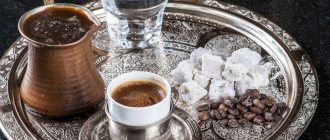Several years ago, a reform of the Russian language took place in our country, which caused considerable controversy. It was after her that it became possible to use the word coffee in the neuter gender. But adherents of the old school do not take this change seriously, and still do not get tired of correcting those who, in their opinion, speak incorrectly. Yes, you can argue endlessly about what kind of word coffee is. But it’s better to immediately figure out which is actually correct – “he” or “it”.
Information from the history and etymology of the word “coffee”
In English, the word is written as coffee, pronounced according to the transcription - [ˈkɒfɪ]. “Coffee” is borrowed from a foreign language. It is generally accepted that it is from English, although there are several versions. There is also an opinion that the roots of the origin of the word go back to the Arabic language. In the region of Ethiopia called Kaffa, coffee trees were grown. As a result, the fruits of the plant, as well as the drink made from them, began to be called in a similar way.
In other languages it sounds like this:
- French - cafe;
- German – kaffe;
- Dutch - coffee.
Our ancestors first tried the drink brought by merchants from the Netherlands. They said “kofi” there, so in Rus' they pronounced “kofiy” or “coffee”. The following forms and derivatives have become common: coffee, drink coffee, coffee, kohei, kefa, coffee, coffee, coffee pot.
Content
- 1 Wiktionary
- 2 Spelling dictionary
- 3 Large explanatory dictionary
- 4 Encyclopedic Dictionary
- 5 Ozhegov's Dictionary
- 6 Dahl's Dictionary
- 7 Explanatory Dictionary by Efremova
- 8 Ushakov’s Explanatory Dictionary
- 9 Types and varieties
- 10 Coffee drinks
- 11 Translation
- 12 Three faces of coffee
- 13 Coffee as medicine 13.1 Links
- 13.2 Bibliography
- 13.3 Quotes
What gender does the word belong to and why?
Previously, schools taught that the word belongs exclusively to the masculine gender, despite the ending -e and borrowed origin. Then, when doubts arose - coffee is “it’s mine” or “it’s mine” - an unequivocal answer was given. Today the situation has changed dramatically.
The first amendment to this rule was made in 2002 in dictionaries:
- Tolovy, author Dahl (1880-1882);
- Ozhegov's dictionary (1949);
- Efremova (1996).
The officially prescribed amendment stated that it was acceptable to use the word “coffee” as neuter, provided that this occurs exclusively in colloquial speech. This mention first appeared in the “Russian Spelling Dictionary” by the author Lopatin.
Everything flows, everything changes, the Russian language also does not stand still. Surveys and studies are constantly being conducted, which have shown the need for further reforms. On September 1, 2009, the Ministry of Education made several significant changes by order. One of them concerned the name of many people’s favorite drink.
Since 2009, “coffee” has also become neuter. This now applies not only to oral speech, but also to written speech. This year's changes are reflected in the directories:
- “Spelling Dictionary of the Russian Language”, Bukchina, Sazonova, Cheltsova;
- “Grammar Dictionary of the Russian Language: Inflection”, Zaliznyak;
- “Dictionary of accents of the Russian language”, Reznichenko;
- “Large Phraseological Dictionary of the Russian Language”, Telius.
For those for whom the innovation seems unacceptable, it is recommended to use the word as a masculine gender to designate a drink, and as a neuter gender to denote a plant and its fruits.
Etymology has its mysteries
It is impossible to unequivocally answer where the word “coffee” came into modern language. Some people insist that the word came into the English dictionary from Dutch. So in 1598, when long-term sea expeditions were in full swing, and trade between countries was developing and flourishing, Dutch traders not only enriched their vocabulary with the new word “koffie”, but also pleased the local nobility with a new gastronomic delight. There is even a theory that coffee came to European languages from Turkey, or more precisely from the Turkish “kahve”.
Other historians insist that the ancestor of the word “coffee” was the Arabic word “qahwa”, which, however, was used to designate a type of local wine. It was not possible to trace the earlier etymology at a scientific level. Therefore, the researchers limited themselves to guessing that the word “qahwa” is the name of the area in Ethiopia where the unique fruits were first discovered. True, in Kaffa itself, the birthplace of the coffee tree, its fruits are called bunna or buno.
As for native speech, the situation is no less clear, which is also complicated by such a grammatical phenomenon as gender. And frankly, some lovers of this tonic hot drink still don’t know what type of their favorite drink is male or average.
Return to content
Morphological analysis of the word
The essence of this type of analysis is to study the word as a part of speech. To do this, you need to indicate its general grammatical meaning, morphological and syntactic features. All these characteristics can be constant or impermanent. When a part of speech is immutable, there are no inconstant properties.
Morphological analysis of the word “coffee”:
- noun;
- initial form – coffee (nominative case, singular);
- common noun, inanimate, masculine and neuter, zero declension;
- inconsistent characteristics - case and number - are absent;
- can be a different part of a sentence depending on the context.
Types and varieties
In nature, there are about 80 species of coffee trees - from dwarf shrubs to 10-meter giants. Man widely cultivates two types of coffee tree for his needs: coffea arabica - Arabica
, coffea canaphora (robusta) -
Robusta
.
According to various estimates, these two types account for up to 98% of the coffee produced. This volume is divided in the ratio of 70% - Arabica
, 30% -
Robusta
. The remaining types account for only 2% of world coffee production.
The most common variety of coffee, Arabica, grows at an altitude of 600 to 2000 meters above sea level. Beautifully shaped beans usually have an oblong shape, a smooth surface, a slightly curved “S”-shaped line, in which, after light roasting, unburned particles of coffee berries usually remain. The Robusta species is fast-growing and more pest-resistant than Arabica, and grows from approximately 0 to 600 m above sea level, primarily in tropical areas of Africa, India and Indonesia. The grains have a round shape, color - from light brown to grayish-green.
Robusta is generally considered less refined in terms of flavor. At the same time, Robusta contains more caffeine and is also often used in espresso blends, which allows for better coffee crema and reduces the cost of the mixture.
Other varieties, such as Liberica
and
Excels
- have no industrial significance.
Composition of the word
According to morphemic analysis, the word “coffee” has a similar basis. This is because the borrowed form does not change regardless of sentence use, case inflection, and number changes. In Russian, the stress in the word “coffee” falls on the first syllable. Pronunciation in foreign languages involves changes in transcription, then emphasis on a different vowel is possible.
Cognates from “coffee”:
- coffee pot;
- coffee maker;
- coffee machine;
- coffee;
- coffee house;
- coffee grinder;
- caffeine.
What does the word "coffee" mean?
In modern Russian, this word has several meanings.
- Plant . Trees of the Rubiaceae genus, belonging to various varieties and species. All of them produce juicy fruits with large grains. They are referred to as “coffee trees.”
- Beans obtained by processing the fruits of the coffee tree. It is correct to say "beans or beans of coffee".
- Ground bean powder is ground coffee.
- The finished drink , which is obtained by brewing or infusing ground beans, is natural coffee.
- Extract from ground grains , on the basis of which instant drinks are prepared - instant coffee.
In all meanings, the word retains the masculine gender, singular number and invariability in cases.
Phonetic analysis of the word
This analysis is needed in order not to lose the meaning of the lettering of the sounds heard. It happens that one thing is written, but pronounced differently. The opposite situation is also possible. Phonetic analysis develops sound attention, the ability to notice something hidden, to feel softening or deafening.
Sound-letter analysis of the word “coffee”:
- k – [k] – consonant, voiceless paired, hard, noisy;
- o – [`o] – vowel, stressed;
- f – [f'] – consonant, voiceless paired, soft, noisy;
- e – [e] – vowel, unstressed.
The word has two syllables, the first one is stressed. There are only 4 letters and 4 sounds, and not all correspond to each other. There are equal numbers of vowels and consonants.
Literature
| coffee in Wiktionary |
| Coffee on Wikibooks |
| Coffee on Wikimedia Commons |
| Coffee on Wikinews |
- Kanovskaya M.B.
Coffee. - M.: AST, 2007. - 94 p. - Pucherov N.N.
All about coffee. - 3rd ed., erased. - K.: Naukova Dumka, 1988. - 104 p. - Pluzhnikov I.I.
A cup of coffee. - M.: Food Industry, 1967. - 95 p. - Pokhlebkin V.V.
Coffee // Culinary dictionary. - M.: E (Eksmo), 2020. - P. 164-167. — 456 p. - Magazine "Oriental Collection". Special issue “Life in a Cup” (“Cup of tea. Cup of coffee”). - M.: RSL, 2020 (No. 64). — 164 p.
- Banks M., McFadden K., Atkinson K.
World Encyclopedia of Coffee = The World Encyclopedia of Coffee. - M.: Rosman-Press, 2002. - 256 p. - Thor Hanson.
Triumph of seeds. How seeds conquered the plant world and influenced human civilization = Thor Hanson The Triumph of Seeds: How Grains, Nuts, Kernels, Pulses, and Pips. - M.: Alpina Publisher, 2018. - 374 p. — ISBN 978-5-91671-809-6. - Pendergrast, Mark.
Uncommon Grounds: The History of Coffee and How It Transformed Our World. - London: Texere, 2001. - ISBN 1-58799-088-1.
Articles
- Zabolotskikh E.
Black, hot, sweet // The New Times: weekly socio-political magazine. - 2011. - March 10 (No. 9 (194)). Archived from the original on September 12, 2011. - Bogdanov K.A.
Coffee in the Russian tradition // About Crocodiles in Russia. Essays on the history of borrowings and exoticisms. - M.: New Literary Review, 2006. - P. 56-67. — 348 p. - Volper I.
The soul of coffee // Chemistry and life: magazine. - 1975. - No. 11. - P. 51-53. - Noel Riley Fitch.
The Grand Literary Cafés of Europe Literary Coffeholics // The Grand Literary Cafés of Europe. - L.: New Holland Publishers, 2006. - 160 p. — ISBN 1-84537-114-3. - What you know and what you don’t know about coffee // Chemistry and life: magazine / Comp. Melnikova Zh. - 1966. - No. 3. - P. 71-78.
- Coffee // Encyclopedic Dictionary of Brockhaus and Efron: in 86 volumes (82 volumes and 4 additional). - St. Petersburg, 1890-1907.
Regulations
- GOST R 52089-2003 (ISO 3509-89) - Coffee. Terms and Definitions.
- GOST R 52088-2003 - Natural roasted coffee. General technical conditions.
- GOST R 51449-99 — Green coffee (raw). Preparation of samples for determination of organoleptic characteristics.
- GOST R 51450-99 - Green coffee (raw). Types of defects.
Declension by case
In Russian, the use of words in a sentence involves a change in form. This occurs due to a change in case, as well as number - singular or plural is used in a particular case. “Coffee” is borrowed from English. Like other similar words, it does not change regardless of its use in speech. Consequently, changing the number and declination by cases will not give anything. The form will remain “coffee”.
Examples of phrases and sentences:
- Strong coffee.
- Ground coffee.
- Turkish coffee.
- The coffee machine is designed for preparing various types of coffee.
- To brew Turkish coffee, it is best to use fine or medium-ground Arabica beans.
- You should think about the right coffee in advance, since choosing among the variety of varieties is not so easy.
- I have to give credit to your coffee - the drink is simply divine.
Sometimes it can be difficult to immediately determine how to correctly pronounce or write a word. Difficulties often arise due to stress, declension, pluralization, or gender determination. The word "coffee" is borrowed from English. Currently, the generally accepted rules for its use in Russian speech have changed; now the name of the drink and the tree can be used not only in the masculine, but also in the neuter gender. The innovation concerns both oral use and written writing.
How to speak correctly
We advise you to adhere to the classical literary norm and use the word “coffee” exclusively in the masculine gender. This way, in any society, you will remain a literate person.
However, it is worth remembering that the use in speech of the phrases “delicious coffee” and others similar to it is currently a fixed norm of the Russian language. If you are used to the idea that coffee is it and can’t stand other options, we recommend not paying attention or making comments to people who say that coffee is it. Such remarks are not only a violation of the rules of politeness, but also an indicator that the person is a bore and a pseudo-intellectual.
It is also worth noting that in the professional coffee community this word is used exclusively in the masculine gender. A self-respecting barista will never say: “Please, here’s your Americano.” We recommend taking into account the opinions of coffee industry professionals. For them, the question of “one coffee or one” is clearly closed.
Three faces of coffee
Coffee can come in three forms: as an aromatic drink, as a medicine, and as a poison. There is nothing unnatural in this, at first glance, unexpected combination, since coffee affects each organism differently. After a cup of coffee, most people feel cheerfulness, a surge of energy, increased efficiency and improved mood, while some, on the contrary, feel uneasy from just the smell of coffee. For such people, even one cup of drink can cause insomnia, headaches, high blood pressure, and anxiety. In addition, some people fall asleep without problems after drinking coffee, while others cannot sleep a wink.











